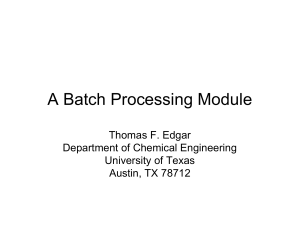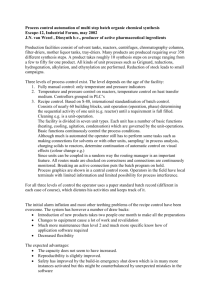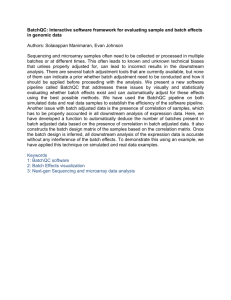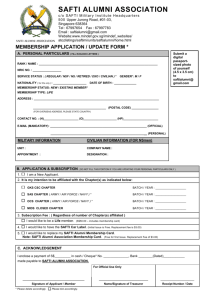“Automatic Control in Semiconductor Manufacturing: Challenges
advertisement
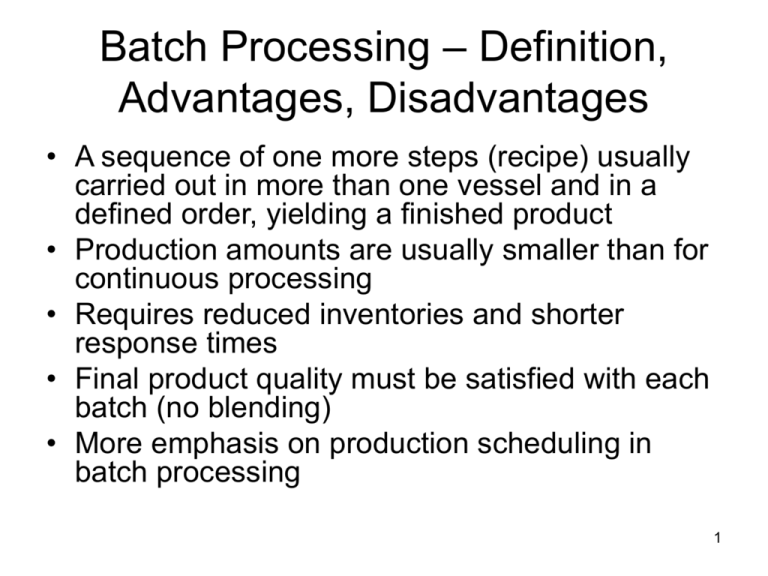
Batch Processing – Definition, Advantages, Disadvantages • A sequence of one more steps (recipe) usually carried out in more than one vessel and in a defined order, yielding a finished product • Production amounts are usually smaller than for continuous processing • Requires reduced inventories and shorter response times • Final product quality must be satisfied with each batch (no blending) • More emphasis on production scheduling in batch processing 1 Other Advantages • Batch time can be adjusted to meet quality specs • Repetition is conducive to continuous improvement in product • Slow dynamics permit real-time calculations • Greater agility 2 3 Batch Processing Used in Manufacturing • • • • • • • • • • Electronic materials Specialty chemicals Metals Ceramics Polymers Food and agricultural materials Biochemicals Multiphase materials/blends Coatings Composites 4 Representative processing steps in a semiconductor wafer fab (Deposition, Patterning, Etching, Doping, etc) 5 Unit operations in microelectronics manufacturing are characterized by: 1. Physical/chemical complexity 2. Inability to measure directly many process variables 3. High sensitivity to process changes 4. Multiple inputs/multiple outputs 6 CD Variation Effects in Pattern Transfer Wafer Reticle Flatness Reflectivity Topography Refractive Index Thickness Uniformity Viscosity Contrast Resist CD Defects Edge Roughness Proximity Effects Temperature Uniformity Time Delay PEB Stepper Aberrations Lens Heating Focus Leveling Dose Time Temperature Dispense Pattern Rinse Develop Etch Power Pressure Flow rates Amines Humidity Pressure Environment 7 Silicon Integrated Circuit Technology Roadmap 8 Comparative Economics Revenue/Capital1 Chemical & Petrochemical 22.4 Pharmaceutical Semiconductor 19.6 6.8 • Capital productivity is a major driving force for semiconductors _______________ 1From 1997 US Census Bureau 9 Why Control Critical Dimension (CD)? • Small changes in CD distribution = Large $ values lost Zero Yield (Low conductance) Zero Yield (High leakage) Higher speed 3s = 36nm 3s = 12nm 210 230 250 Gate CD (nm) 270 290 10 Figure 19.1 The five levels of process control and optimization in manufacturing. Time scales are shown for each level. 11 Control Hierarchy in Batch Processing 1. Sequential control to step the process through a recipe 2. Logic control to deal with device interlocks 3. Within-the-batch control to make set point changes and reject disturbances 4. Run-to-run control to meet final quality constraints 5. Batch production control to maximize utilization of equipment and minimize cycle time 12 Batch Mixing Tank-Operations Sequence 1. Introduce liquid A until level reaches LH2 2. Close A valve, open B valve and start mixer 3. When level reaches LXH2, stop flow of B and the mixer and open discharge valve (VN9) 4. Discharge product until level reaches LL2, then close the discharge valve. 13 Figure 22.7 14 Graphical Description of Batch Sequence • • • • Information flow diagram Sequential function chart Binary logic diagram Ladder logic diagram 15 Figure 22.8 16 Within-the-Batch Control: Operational Challenges • Time-varying process characteristics (no steady state) • Nonlinear behavior • Model inaccuracies • On-line sensors often not available • Constrained operation • Unmeasured disturbances • Irreversible behavior 17 18 1000C Temperature 0 Time 10 sec Figure 3. Definition of bring-in (Rapid Thermal Processing) 19 Run-to-Run (RtR) Control • Keeps batch process product on target by using feedback to manipulate batch recipe for consecutive batches • Required due to a lack of in situ, real-time measurements of product quality of interest • Extremely useful where initial conditions or tool states are variable and unmeasurable • Supervisory controller determines optimal setpoints for real-time control loops (typically PID) 20 RtR Control • Predominantly used in semiconductor and batch chemical industries • Can be viewed as discrete-time process (k, k+1, k+2 … vs. t) • Good for treating drifting processes (e.g. reactor fouling) • Run-to-run optimization can be performed using process model • Integrates with fault detection 21 Use of RtR Control • Examples of events which can have slow dynamics or infrequent step changes - - equipment aging periodic machine maintenance changes in feedforward signal - measure disturbance major fault, such as instrumentation degradation 22 Application: Resist etch process • The incoming pattern is masked with linewidths greater than required. • An additional step is added to the etch process which etches the resist pattern. • The resist etch step trims the lines to the proper resist linewidth. • The rest of the etch transfers the resulting mask pattern into the polysilicon, creating the poly gate structures. Linewidth SiON Trimmed Resist Poly Silicon STI Gate Oxide Silicon Substrate STI 23 Results – Increased Cpk 40 Prior to APC Implementation With Automated Run-to-Run Control Frequency 30 20 10 0 -1 -0.9 -0.8 -0.7 -0.6 -0.5 -0.4 Metric Mean Deviation From Target Standard Deviation Cpk -0.3 -0.2 -0.1 0 0.1 0.2 0.3 Normalized Deviation From Target Uncontrolled -0.201 0.254 1.05 0.4 0.5 0.6 0.7 0.8 Controlled 0.045 0.188 1.7 0.9 1 % Change -77% -26% +62% 24 Reduction in STI Rework with RtR Fab 25 STI Rework Rate 6.00% Standard SPC Charting Process Control Manual Implementation of APC Algorithm Percent Rework 5.00% Automated Implementation of APC Algorithm 4.00% 3.00% 2.00% 1.00% 0.00% 1998 Work Week 25 Figure 22.19 Batch control system – a more detailed view 26 Characteristics of batch scheduling and planning problems (Pekny and Reklaitis) DETERMINE GIVEN What Product amounts: lot sizes, batch Sizes Product requirements Horizon, demands, starting and Ending inventories When Timing of specific operations, run lengths Operational steps Precedence order Resource utilization Where Sites, units, equipment items Production facilities Types, capacities How Resource types and amounts Resource limitations Types, amounts, rates 27 Welcome to the Real World! • For a real lot in a real fab, there are: – – – – – – – – Reworks Different process equipment at previous steps WIP ordering/processing Equipment/Consumable material changes Recipe changes/adjustments Scheduled/Unscheduled maintenance Multiple reticle instances Engineering lots 28 Figure 22.17 Multiproduct batch plant 29 Multi-Product Processing Overview Fab Tool A B B A A B Process 1 Fab Tool Process 1 A A A A Process 2 Fab Tool Process 1 A B B A A B Process 2 30 Metrology Variations 4 3. 5 3 Correct Metrology Ordering 2. 5 2 1. 5 1 0. 5 Process 0 A B C D E 2 4 1. 8 3. 5 1. 6 1. 4 3 1. 2 2. 5 1 Incorrect Metrology Ordering 2 0. 8 1. 5 0. 6 1 0. 4 0. 5 0. 2 0 0 A B C D E E D C B A 4 3. 5 Incorrect Metrology Ordering 3 2. 5 2 1. 5 1 0. 5 0 C D A E B 31
